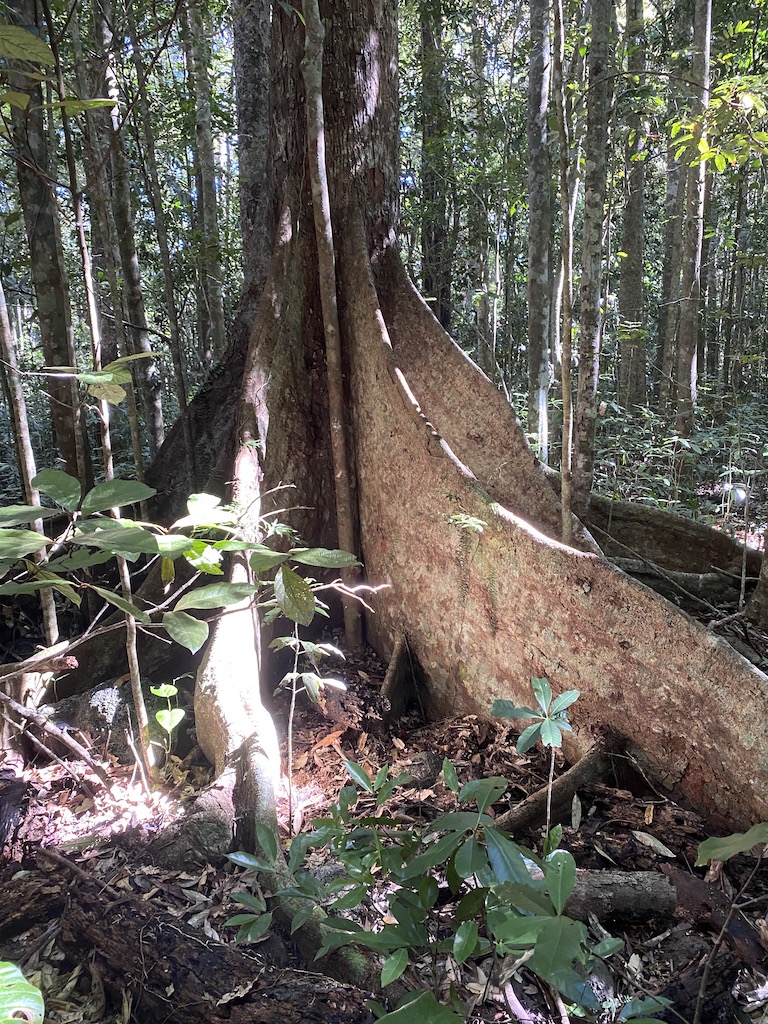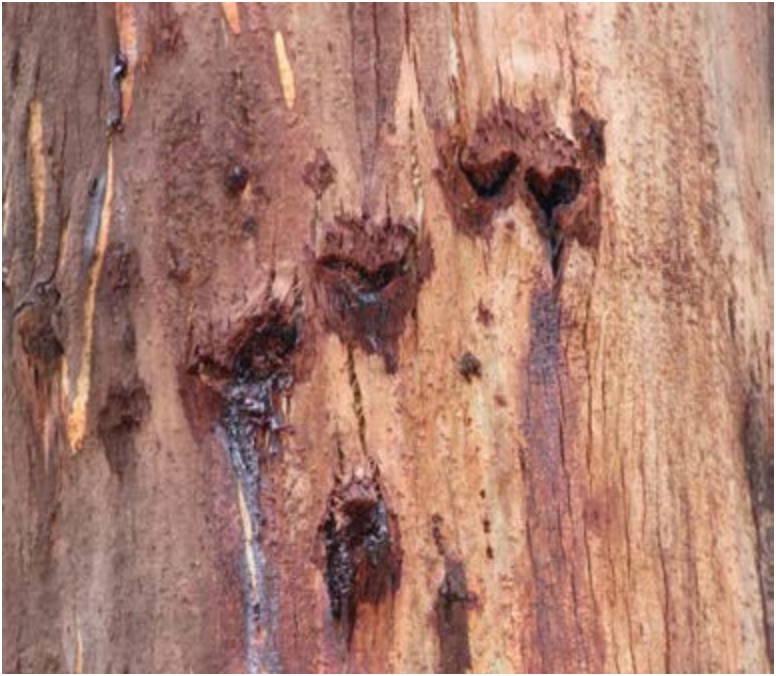During our trip around Queensland (Qld), we have visited several forests and walked their trails. Some have included rainforests. The main distinguishing features of these rainforests are high rainfall and fertile soils, such as basalt. Rainforests have a multi-layered canopy of up to 50 tree species, many of which exhibit buttressing. These include booyong (Argyrodendron spp), lilly pilly (Syzgium spp) and yellow carabeen (Sloanea woolsii). They also support the ubiquitous strangler fig (Ficus spp), woody vines and large epiphytes such as birdnest, elk and staghorn ferns.

As a forester, I always found it very difficult to identify tall rainforest trees. Unlike eucalypts, where the main distinguishing feature is its bark, which allows you to group them quickly, the main morphological features that identify rainforest trees are the leaves and their arrangement on the stem. However, it is difficult to see the leaves on the large trees from the ground, and it is not always easy to use the decaying leaves as a guide found on the forest floor. The harvesting of rainforests had stopped in New South Wales (NSW) when I started my forestry career, so I didn’t spend a great deal of time working in those forests assessing and learning their intricate details, as I did in the eucalypt forests.
But this didn’t stop me visiting the rainforests at every opportunity. The recent walks through rainforests reminded me of my younger work experiences on the north coast of NSW. There are three main types of rainforest in the Bellinger and Nambucca Valleys. The most common, found in protected gullies between the exposed ridges, are sub-tropical rainforest and warm temperate rainforests. Usually in small patches along the valleys, they don’t cover the same extent as those on top of volcanic plateaus such as the border Ranges on the NSW/Qld border or northern Qld. The latter has a much less complicated structure than the sub-tropical rainforest and usually occurs on more deficient soils. One of the things I enjoyed most in the Bellinger Valley when walking from one ridge to another, was finding the rare rainforest plant called ringwood (Backhousia anistata). As the name suggests, it has a strong aniseed aroma when you crushed the leaves in your hand.
Littoral, or coastal, rainforest is found in the swale behind the coast’s first dune. There was a great example near Bundagen where, during summer, I would find any excuse to visit. I was in charge of organising weed control efforts in the Flora Reserve. During spring and summer, I would often visit to check on the progress of bitou bush spraying and take the opportunity to wander onto the isolated beach and have a refreshing skinny dip.
While working on an Environmental Impact Statement for our district, I recall reading about an obscure small patch of cool temperate rainforest supporting Antarctic beech (Nothofagus moorei) high on a range. From memory, this was unique in that it was the most easterly location of this rainforest type in NSW. I pored over our forest type maps and mapped it out and planned a day walking through the forest to see it and provide a report for our files but unfortunately never got to view it. I thought it was in the Bellinger River State forest (which is now a National Park). I note that the current Management Plan for the new National Park does not mention this unique community. A vegetation study, carried out not long after it became a National park in 1999, made no mention of it so I may have the exact location wrong.
One of the more fascinating and isolated rainforest features I found was in the Nambucca Valley’s southern end at Ingalba State forest. This forest is located on moderately fertile soil but often shallow and heavily textured which blackbutt (Eucalyptus pilularis) dislikes. Consequently, it is one of the few coastal forests in the Nambucca and Bellinger Valleys not dominated by blackbutt because rooting depth, soil aeration and permeability were restricted.
Ingalba State forest supports dry coastal hardwoods called the ‘royal’ species – sturdy, durable and slower growing trees such as grey gum (E. propinqua), grey ironbarks (E. crebra, E. siderophloia)[1], and narrow-leaved white mahogany (E. acmenoides). These ‘dry’ forests tend to support a more open understory free of shrubs as fire is more common, particularly low intensity burns. Today, however, that demarcation is harder to distinguish as we see more commonly an explosion of mesic shrub species invading these areas due to a lack of active management and carbon fertilisation.
Once the dry hardwoods’ durability was recognised, these forests were selectively logged for poles, girders, piles, and sleepers over several years. A 1982 Forestry Commission Research Report highlighted the strength and durability of these species. It referred to an 80-year-old ironbark railway bridge that showed no indication of any reduction in strength of the wood away from the surface weathering.
I was never a fan of single sleeper cutter felling, as opposed to integrated operations that cut a range of products, depending on the quality of the tree felled. It was not necessarily because of any regeneration concerns, as the dry hardwood trees reliably regenerate via coppice or the release of lignotubers in the advance growth pool. In sleeper only operations, cutters fall the best trees and leave the more inferior growing trees behind. Commonly known as ‘high-grading’ this is not good for long term forest productivity. We were fortunate that Ingalba was managed for over 60 years by father and son. They instilled a reliable and consistent silvicultural ethic that ensured areas logged were kept in check and they promoted a range of ages to ensure a sustainable crop – similar to the group selection in coastal uneven-aged blackbutt forests, but on a single tree selective system. Years later, at Kirrawat State forest near Taree, I found a different situation. When I arrived there as District Forester in 1995, I was not popular when I stopped the sleeper operations as there had been minimal management control and the cutters were ‘high grading’ the forest.[2] I had to explain my decision to the Minister’s office following strong representations made on the sleeper’s behalf.

I remember coming across pockets on more sheltered aspects within Ingalba State forest that contained some outstanding trees. One of those was what I believed to be the tallest red cedar (Toona australis) alive. I can’t remember the dimensions, but the local office files should still have my record of this trip. The forest also has magnificent examples of tall southern grey ironbark over 50 metres tall and narrow-leaved white mahogany over 60 metres tall.[3] This forest is also a stronghold for the yellow-belied glider (Petaurus australis) where grey gum provides vital sap and nectar supplies.

Next time you find yourself bushwalking in a forest, take a close look at the trees and the understory so you can work out if you are in a rainforest or a dry forest or something in between. A rainforest doesn’t have any eucalypts and is not dependent on fire to rejuvenate, unlike wet and dry eucalypt forests.
[1] There are several closely related ironbark species found in the forest. The most common is Eucalyptus siderophloia, E. crebra andE. fibrosa subsp fibrosa. While I was working there, taxonomists identified a new rare species – E. fusiformis and typical of taxonomists, the only way to distinguish it was via to study the stamens under a microscope which makes it impossible to identify in the field.
[2] This is not necessarily a criticism of the managers before me as they had other priorities to deal with in terms of continual forest blockades when trying to access and harvest unlogged forests further up the Manning Valley. ‘High grading’ or colloquially known as “cutting the best and leaving the rest” is a pejorative term which refers to the selective removal of the biggest and best trees, usually prematurely, in a stand and the retention of very young and defective or lower grade trees, thus reducing the productivity and sustainability of the forest. In an ideal silvicultural situation, foresters aim to retain trees with good form and potential to grow and reach their maximum value and progressively remove defective and lesser quality trees. The ability to achieve this ideal, however, is dependent on available markets for the lower quality trees.
[3] At the base of this tree, I recall there is (or was) the stump hole of a much larger ironbark, probably 3-4.5m diameter at breast height.